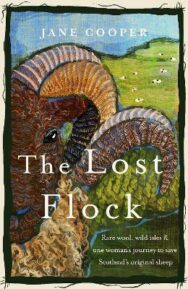‘I hope readers could be inspired to consider that there can be different ways of doing things, that thinking outside the box and taking a risk in terms of quality of life for many rather than just chasing short term profit may be the greater good for all and make our communities better and happier places to live in.’
The Lost Flock is the untold, real-life detective story of the remarkable little horned sheep known as the Orkney Boreray, and Jane Cooper – the determined woman who moved to one of Scotland’s wildest islands to save them. In this Q&A, Jane tells us more about this incredible story and its background.
The Lost Flock
By Jane Cooper
Published by Chelsea Green Publishing
Can you tell us a little bit about what readers should expect from The Lost Flock?
The universal comment I’ve had from people is that they have really enjoyed reading it. So I hope readers can expect an enjoyable experience, and one where they are likely to learn something new and interesting.
The book has a number of different themes and strands weaving through it – perhaps reflecting the diverse interests and activities I’ve had in my life. While knitting and wool is a lifetime interest that has led to so much more, I’ve also found that one is never too old to learn something new and have new experiences and challenges.
What was it about the story of the Lost Flock, the Orkney Boreray sheep, that initially enthralled you?
It was the character of the sheep when I first met them in person that really captured me, although it was their fleece that led to me meeting them. Then when I started learning about them the fact that they had survived for some decades outside the Rare Breeds Survival Trust ‘fold’ of registration, but in the care of people, Bob and Ann Cook, who kept meticulous breeding records, did very much interest me. Bob shared with me the research he’d done on their origins, and a paper written about the origins of the registered Boreray sheep outside St Kilda, and the scientist in me was intrigued. For events that had happened within my lifetime I was very surprised to find there was some key information that wasn’t known or had already been forgotten.
Having studied my own family history and finding direct ancestors, not too distant, that had left Scotland for the north east of England during the period of the Highland Clearances, I was keen to try and find out more about their lives in Scotland. My delight at finding other ancestors in Northumberland who had farmed sheep, likely an early form of Border Leicester, was tempered by my dismay at learning that the little sheep of the Highland crofters, recorded as being related to Boreray sheep, were now listed as extinct. But the story of these little sheep from Boreray that had survived as a feral flock in St Kilda really caught my imagination. There is something that really captures the imagination about the inhabitants of an island, Hirta in St Kilda, out in the ocean surviving against such odds for so many centuries, but then being forced to leave all they had known and evacuate their ancestral home.
What can we learn about the history of human settlement in Scotland through the study of the Lost Flock’s origins?
The fact that the primitive short-tailed sheep of Scotland have survived very little changed since they first came into Scotland with Neolithic farmers 6000 years ago can teach us a lot about how sheep were kept and farmed through Scotland’s history. Orkney has its own native sheep, the North Ronaldsay, that has been compared with ancient skeletal from archaeological sites in Orkney and research has shown how these sheep were used by the early farmers, what the sheep ate, and what products came from them. Few people nowadays think of sheep as providers of milk, but sheep milk was an important part of the diet throughout history because it could be made into cheese – a nutritious, high protein food that can be stored for long periods without refrigeration. By keeping sheep overnight in folds made of moveable hurdles they could be used to deposit their dung where the ground needed fertilising for growing food crops. Wool of course was an essential fibre for clothing from the Bronze age onwards, having a number of unique properties that were useful in Scotland’s wet and cold climate. Sheepskin is useful not just for leather but for making the parchment used for so many documents important in Scotland’s history. The custom of using sheep as a source primarily of meat from young animals is very recent.
When we look at the period when Vikings were involved with Scotland then sheep were crucial to their lives and exploration. Wool in vast quantities was necessary for their clothing, bedding and the sails of their longships and boats. The need for around two million sheep could well have influenced some of their exploration and invasion. The time consuming process of turning raw fleece into sails and clothing, all jobs carried out by women, could well have influenced their capturing of female slaves.
Moving forward into recorded history we find written descriptions of how Highland crofters survived for so many years before the period of the Highland Clearances, including how they managed their tiny flocks of Dunface sheep.
What changes can we make on both an individual and structural level to make sure current animal species are not lost to future generations?
Since the Rare Breeds Survival Trust started 50 years ago no breed of livestock has become extinct. Many individuals are involved with the work of the RBST, either by keeping rare breeds of livestock, supporting those who do, or buying products from the breeds which provides essential income for farmers, crofters and smallholders. Rare breeds do not fit neatly into the structure of industrial farming and the processing and selling of meat. Choosing a treat of meat from a rare breed, readily available from specialist butchers or direct from farms, often by mail order, is a significant way individuals can support the sustainability of rare breeds. Buying other products from rare breed livestock, including the renewable resource of wool from rare breed sheep also provides an opportunity for individuals to support rare breeds.
At a structural level the most important thing that is needed to ensure the survival and sustainability of rare breeds of livestock is government support for small, local abattoirs which are closing at an alarming rate. Governments must recognise that they are vital infrastructure for rural communities that are as deserving of public support as any other public infrastructure such as schools. The regulatory burden on small abattoirs needs to be reduced so that it is proportionate to the risk. There is a world of difference between small local abattoir business interacting directly with the farmers using their services and and what regulations are needed for their safe operation compared to the level of regulations needed to ensure the food safety and environmental safety of large industrial abattoirs.
Rare breeds can thrive on land unsuitable for any other livestock and can offer much for conservation grazing, increasing biodiversity in habitats, and as a gene pool of disease resistance that may well be needed for future breeding of commercial livestock. Any government support for agriculture should include support for the keeping of rare breeds as a public good in itself.
Is there one thing you would like readers to take from the book?
Looking at the agroecological principles of the Orkney Boreray Community, including its fair trade ethos, I hope readers could be inspired to think how such principles could enrich their lives and their communities. To consider that there can be different ways of doing things, that thinking outside the box and taking a risk in terms of quality of life for many rather than just chasing short term profit may be the greater good for all and make our communities better and happier places to live in.
If I’m allowed a second thing, it would be not to always accept what is accepted fact and to be open to improbable possibilities. The example here is that the Dunface sheep, Scotland’s very own historical Highland sheep, were not wiped out and made extinct in 1880, but survived almost unchanged on a little uninhabited island out in the Atlantic.
The Lost Flock by Jane Cooper is published by Chelsea Green Publishing, priced £20.00.
ALSO IN THIS ISSUE

 Wild Hope: Healing Words to Find Hope in Dark Days
Wild Hope: Healing Words to Find Hope in Dark Days
‘you may not consider poetry important / but if you had seen / a poem breathe life / into empty lung …

 My Lady Parts: A Life Fighting Stereotypes
My Lady Parts: A Life Fighting Stereotypes
‘I found myself on the first day at Kilrymont School, on the outskirts of St Andrews, crushed by a t …













